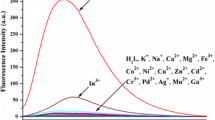Abstract
A novel, 100% water-soluble chalcone based chemosensing receptor {1-[3-(2-Hydroxy-phenyl)-3-oxo-propenyl]-naphthalen-2-yloxy}-acetic acid, L was synthesized and characterized. The receptor L is designed based on the chelation enhanced fluorescence (CHEF) mechanism. The chemosensing properties of L were evaluated by UV–vis and fluorescence spectrometric methods. It exhibits highly selective recognition ability towards aluminum ions in water over other metal ions. The binding stoichiometry of L− Al3+ complex is 2:1 by means of Job’s plot and the detection limit is 5.66 × 10− 8 M.









Similar content being viewed by others
References
Kriegeskotte C, Cantz T, Haberland J, Zibert A, Haier J, Köhler G, Schöler HR, Schmidt HHJ, Arlinghaus HF (2009) Laser secondary neutral mass spectrometry for copper detection in micro-scale biopsies. J Mass Spectrom 44(10):1417–1422
Frankowski M, Zioła-Frankowska A, Siepak J (2010) New method for speciation analysis of aluminium fluoride complexes by HPLC–FAAS hyphenated technique. Talanta 80(5):2120–2126
del Castillo Busto ME, Montes-Bayón M, Blanco-González E, Meija J, Sanz-Medel A (2005) Strategies to study human serum transferrin isoforms using integrated liquid chromatography ICPMS, MALDI-TOF, and ESI-Q-TOF detection: application to chronic alcohol abuse. Anal Chem 77(17):5615–5621
Liu W, Xu L, Sheng R, Wang P, Li H, Wu S (2007) A water-soluble “switching on” fluorescent chemosensor of selectivity to Cd2+. Org Lett 9(19):3829–3832
Narayanaswamy N, Govindaraju T (2012) Aldazine-based colorimetric sensors for Cu2+ and Fe3+. Sensors Actuators B 161(1):304–310
Dai H, Xu H (2011) A water-soluble 1,8-naphthalimide-based ‘turn on’ fluorescent chemosensor for selective and sensitive recognition of mercury ion in water. Bioorg Med Chem Lett 21(18):5141–5144
Soroka K, Vithanage RS, Phillips DA, Walker B, Dasgupta PK (1987) Fluorescence properties of metal complexes of 8-hydroxyquinoline-5-sulfonic acid and chromatographic applications. Anal Chem 59(4):629–636
Lu Y, Huang S, Liu Y, He S, Zhao L, Zeng X (2011) Highly selective and sensitive fluorescent turn-on chemosensor for Al3+ based on a novel photoinduced electron transfer approach. Org Lett 13(19):5274–5277
Crapper DR, Krishnan SS, Dalton AJ (1973) Brain aluminum distribution in alzheimer’s disease and experimental neurofibrillary degeneration. Science 180(4085):511–513
Flaten TP (2001) Aluminium as a risk factor in Alzheimer’s disease, with emphasis on drinking water. Brain Res Bull 55(2):187–196
Darbre PD, Pugazhendhi D, Mannello F (2011) Aluminium and human breast diseases. J Inorg Biochem 105(11):1484–1488
Darbre PD, Mannello F, Exley C (2013) Aluminium and breast cancer: Sources of exposure, tissue measurements and mechanisms of toxicological actions on breast biology. J Inorg Biochem 128:257–261
Goodman WG (1985) Bone disease and aluminum: pathogenic considerations. Am J Kidney Dis 6(5):330–335
Rout GR, Samantaray S, Das P (2001) Aluminium toxicity in plants: a review. Agronomie 21(1):3–21
Gou C, Qin S-H, Wu H-Q, Wang Y, Luo J, Liu X-Y (2011) A highly selective chemosensor for Cu2+ and Al3+ in two different ways based on salicylaldehyde Schiff. Inorg Chem Commun 14(10):1622–1625
Gupta VK, Singh AK, Kumawat LK (2014) Thiazole Schiff base turn-on fluorescent chemosensor for Al3+ ion. Sensors Actuators B 195:98–108
Kim S, Noh JY, Kim KY, Kim JH, Kang HK, Nam S-W, Kim SH, Park S, Kim C, Kim J (2012) Salicylimine-based fluorescent chemosensor for aluminum ions and application to bioimaging. Inorg Chem 51(6):3597–3602
Jang YK, Nam UC, Kwon HL, Hwang IH, Kim C (2013) A selective colorimetric and fluorescent chemosensor based-on naphthol for detection of Al3+ and Cu2+. Dyes Pigm 99(1):6–13
Shyamal M, Mazumdar P, Maity S, Sahoo GP, Salgado-Morán G, Misra A (2016) Pyrene scaffold as real-time fluorescent turn-on chemosensor for selective detection of trace-level Al(III) and its aggregation-induced emission enhancement. J Phys Chem A 120(2):210–220
Jun Lee J, Jin Park G, Sung Kim Y, Young Lee S, Ji Lee H, Noh I, Kim C (2015) A water-soluble carboxylic-functionalized chemosensor for detecting Al3+ in aqueous media and living cells: experimental and theoretical studies. Biosens Bioelectron 69:226–229
Hwang IH, Choi YW, Kim KB, Park GJ, Lee JJ, Nguyen L, Noh I, Kim C (2016) A highly selective and sensitive fluorescent turn-on Al3+ chemosensor in aqueous media and living cells: experimental and theoretical studies. New J Chem 40(1):171–178
Dey S, Halder S, Mukherjee A, Ghosh K, Roy P (2015) Development of highly selective chemosensor for Al3+: effect of substituent and biological application. Sensors Actuators B 215:196–205
Acknowledgements
The main author (G.-Y.Yeap) gratefully acknowledges Malaysian Ministry of Higher Education (MOHE) for funding this project through FRGS Grant No.203/PKIMIA/6711422.
Author information
Authors and Affiliations
Corresponding author
Rights and permissions
About this article
Cite this article
Yeap, GY., Chan, YH. & Mahmood, W.A.K. Novel Fluorometric Turn On Detection of Aluminum by Chalcone-Based Chemosensor in Aqueous Phase. J Fluoresc 27, 2017–2022 (2017). https://doi.org/10.1007/s10895-017-2140-0
Received:
Accepted:
Published:
Issue Date:
DOI: https://doi.org/10.1007/s10895-017-2140-0




